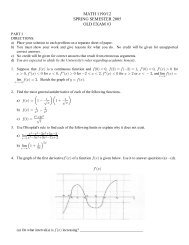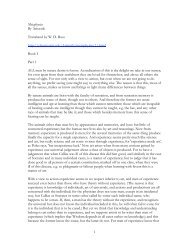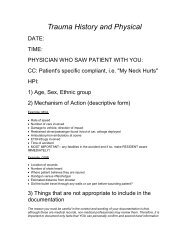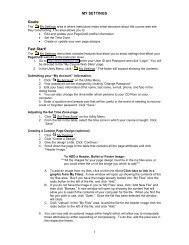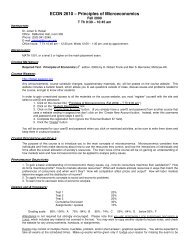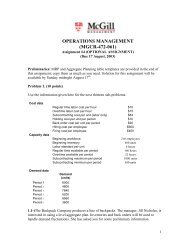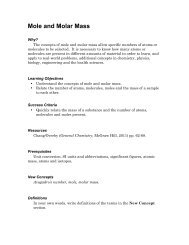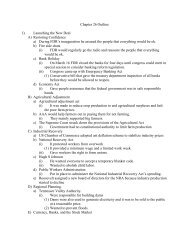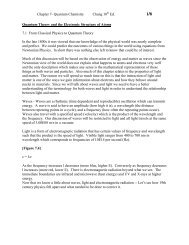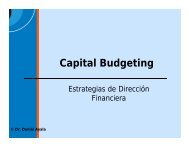Chapter 2 E-commerce Business Models and Concepts - PageOut
Chapter 2 E-commerce Business Models and Concepts - PageOut
Chapter 2 E-commerce Business Models and Concepts - PageOut
- No tags were found...
You also want an ePaper? Increase the reach of your titles
YUMPU automatically turns print PDFs into web optimized ePapers that Google loves.
<strong>Chapter</strong> 2E-<strong>commerce</strong> <strong>Business</strong><strong>Models</strong> <strong>and</strong> <strong>Concepts</strong>Copyright © 2007 Pearson Education, Inc. Slide 2-1
Online Groceries: Up from the EmbersClass Discussion• Why do you think Webvan.com failed?• Why are more traditional grocery chains succeedingtoday?• Why would online customers pay the same prices as inthe stores plus pay delivery charges? What’s thebenefit to the customer?• What are the important success factors forFreshDirect?• Do you think FreshDirect would work in your town?Copyright © 2007 Pearson Education, Inc. Slide 2-2
E-<strong>commerce</strong> <strong>Business</strong> <strong>Models</strong>—Definitions• <strong>Business</strong> model• Set of planned activities designed to result in aprofit in a marketplace• <strong>Business</strong> plan• Describes a firm’s business model• E-<strong>commerce</strong> business model• Uses/leverages unique qualities of Internet <strong>and</strong>WebCopyright © 2007 Pearson Education, Inc. Slide 2-3
Key Ingredients of a <strong>Business</strong> ModelTable 2.1, Page 67Copyright © 2007 Pearson Education, Inc. Slide 2-4
Value Proposition• Defines how a company’s product or servicefulfills the needs of customers• Questions to ask:• Why will customers choose to do business withyour firm instead of another?• What will your firm provide that others do not orcannot?• Examples of successful value propositions:• Personalization/customization• Reduction of product search, price discovery costs• Facilitation of transactions by managing productdeliveryCopyright © 2007 Pearson Education, Inc. Slide 2-5
Revenue Model• Describes how the firm will earn revenue,generate profits, <strong>and</strong> produce a superiorreturn on invested capital• Major types:• Advertising revenue model• Subscription revenue model• Transaction fee revenue model• Sales revenue model• Affiliate revenue modelCopyright © 2007 Pearson Education, Inc. Slide 2-6
Market Opportunity• Refers to a company’s intended marketspace<strong>and</strong> the overall potential financialopportunities available to the firm in thatmarketspace• Marketspace: area of actual or potentialcommercial value in which company intends tooperate• Realistic market opportunity: defined by revenuepotential in each of market niches in whichcompany hopes to competeCopyright © 2007 Pearson Education, Inc. Slide 2-7
Competitive Environment• Refers to the other companies selling similarproducts <strong>and</strong> operating in the samemarketspace• Influenced by:• how many competitors are active• how large their operations are• the market share for each competitor• how profitable these firms are• how they price their products• Includes both direct competitors <strong>and</strong> indirectcompetitorsCopyright © 2007 Pearson Education, Inc. Slide 2-8
Competitive Advantage• Achieved when a firm can produce a superiorproduct <strong>and</strong>/or bring product to market at alower price than most, or all, of competitors• Types of competitive advantage include:• First mover advantage• Unfair competitive advantageCopyright © 2007 Pearson Education, Inc. Slide 2-9
Market Strategy• Plan that details how a company intends toenter a new market <strong>and</strong> attract customers• Best business concepts will fail if not properlymarketed to potential customersCopyright © 2007 Pearson Education, Inc. Slide 2-10
Organizational Development• Describes how the company will organize thework that needs to be accomplished• Work is typically divided into functionaldepartments• Move from generalists to specialists ascompany growsCopyright © 2007 Pearson Education, Inc. Slide 2-11
Management Team• Employees of the company responsible formaking the business model work• Strong management team gives instantcredibility to outside investors• Strong management team may not be able tosalvage a weak business model, but shouldbe able to change the model <strong>and</strong> redefine thebusiness as it becomes necessaryCopyright © 2007 Pearson Education, Inc. Slide 2-12
Categorizing E-<strong>commerce</strong> <strong>Business</strong> <strong>Models</strong>:Some Difficulties• No one correct way• We categorize business models according toe-<strong>commerce</strong> sector (B2C, B2B, C2C)• Type of e-<strong>commerce</strong> technology used canalso affect classification of a business model• Some companies use multiple businessmodelsCopyright © 2007 Pearson Education, Inc. Slide 2-13
B2C <strong>Business</strong> <strong>Models</strong>: Portal• Offers powerful search tools plus anintegrated package of content <strong>and</strong> services• Typically utilizes a combinedsubscription/advertising revenues/transactionfee model• May be general or specialized (vortal)Copyright © 2007 Pearson Education, Inc. Slide 2-14
B2C <strong>Business</strong> <strong>Models</strong>: E-tailer• Online version of traditional retailer• Types include:• Virtual merchants• Bricks-<strong>and</strong>-clicks• Catalog merchants• Manufacturer-directCopyright © 2007 Pearson Education, Inc. Slide 2-15
B2C <strong>Business</strong> <strong>Models</strong>: Content Provider• Information <strong>and</strong> entertainment companiesthat provide digital content over the Web• Typically utilizes a subscription, pay fordownload, or advertising revenue model• Syndication a variation of st<strong>and</strong>ard contentprovider modelCopyright © 2007 Pearson Education, Inc. Slide 2-16
B2C <strong>Business</strong> <strong>Models</strong>: Transaction Broker• Processes online transactions for consumers• Primary value proposition—saving time <strong>and</strong>money• Typical revenue model—transaction fee• Industries using this model include:• Financial services• Travel services• Job placement servicesCopyright © 2007 Pearson Education, Inc. Slide 2-17
B2C <strong>Business</strong> <strong>Models</strong>: Market Creator• Uses Internet technology to create marketsthat bring buyers <strong>and</strong> sellers together• Examples:• Priceline.com• eBay.com• Typically uses a transaction fee revenuemodelCopyright © 2007 Pearson Education, Inc. Slide 2-18
B2C <strong>Business</strong> <strong>Models</strong>: Service Provider• Offers services online• Value proposition: valuable, convenient, timesaving,low-cost alternatives to traditionalservice providers• Revenue models: subscription fees or onetimepaymentCopyright © 2007 Pearson Education, Inc. Slide 2-19
B2C <strong>Business</strong> <strong>Models</strong>: Community Provider• Sites that create a digital online environmentwhere people with similar interests cantransact, communicate, <strong>and</strong> receive interestrelatedinformation.• Typically rely on a hybrid revenue model• Examples:• iVillage• Friendster• About.comCopyright © 2007 Pearson Education, Inc. Slide 2-20
Insight on Technology: Search, Ads, <strong>and</strong>Apps: The Future For Google (<strong>and</strong> Microsoft)Class Discussion• How many of you use Google, Yahoo, orMSN search engines? Does the class differfrom the overall Web population?• Why do you use a particular search engine?• Why are search engines so profitable?• Why do people stay longer at Yahoo <strong>and</strong>MSN.com when compared to Google? Doesthis give them an advantage?Copyright © 2007 Pearson Education, Inc. Slide 2-21
B2B <strong>Business</strong> <strong>Models</strong>: E-distributor• Supplies products <strong>and</strong> services directly toindividual businesses• Owned by one company seeking to servemany customers• Example: Grainger.comCopyright © 2007 Pearson Education, Inc. Slide 2-22
B2B <strong>Business</strong> <strong>Models</strong>: E-procurement• Creates <strong>and</strong> sells access to digital electronicmarkets• B2B service provider is one type• Application service providers: a subset ofB2B service providers• Example:AribaCopyright © 2007 Pearson Education, Inc. Slide 2-23
B2B <strong>Business</strong> <strong>Models</strong>: Exchanges• Electronic digital marketplace where suppliers<strong>and</strong> commercial purchasers can conducttransactions• Usually owned by independent firms whosebusiness is making a market• Generate revenue by charging transactionfees• Usually serve a single vertical industry• Number of exchanges has fallen dramaticallyCopyright © 2007 Pearson Education, Inc. Slide 2-24
Insight on <strong>Business</strong>: Onvia EvolvesClass Discussion• Why did Onvia have a difficult time with itsearly business model?• What type of B2B business model is Onviausing now? Is it still an “exchange?”• Why is the government market succeeding?What services does Onvia provide togovernment buyers? To small businesssellers?• How does Onvia make money?Copyright © 2007 Pearson Education, Inc. Slide 2-25
B2B <strong>Business</strong> <strong>Models</strong>: Industry Consortia• Industry-owned vertical marketplaces thatserve specific industries• Horizontal marketplaces, in contrast, sellspecific products <strong>and</strong> services to a widerange of industries• Example: ExostarCopyright © 2007 Pearson Education, Inc. Slide 2-26
B2B <strong>Business</strong> <strong>Models</strong>: Private IndustrialNetworks• Digital networks designed to coordinate theflow of communications among firmsengaged in business together• Single firm network: the most common form(Example: Wal-Mart)• Industry-wide networks: often evolve out ofindustry associations (Example: Agentrics)Copyright © 2007 Pearson Education, Inc. Slide 2-27
<strong>Business</strong> <strong>Models</strong> in Emerging E-<strong>commerce</strong>Areas• Consumer-to-Consumer (C2C): Provides away for consumers to sell to each other, withthe help of an online marketmaker• Peer-to-Peer (P2P): Links users, enablingthem to share files <strong>and</strong> common resourceswithout a common server• M-<strong>commerce</strong>: E-<strong>commerce</strong> business modelsthat use wireless technologies• To date, m-<strong>commerce</strong> a disappointment in theUnited States; however, technology platformcontinues to evolveCopyright © 2007 Pearson Education, Inc. Slide 2-28
Insight on Society: Is Privacy Possiblein a Wireless World?Class Discussion• Why should you care if companies <strong>and</strong> governmentagencies track your cell phone? What is the threat ifyou are not doing anything wrong?• What is the “opt-in” principle <strong>and</strong> how does it protectprivacy?• Should business firms be allowed to call cell phoneswith advertising messages based on location?• Should customer location information be protectedfrom government agencies?Copyright © 2007 Pearson Education, Inc. Slide 2-29
E-<strong>commerce</strong> Enablers: The Gold RushModel• Internet infrastructure companies• Provide hardware, software, networking, security,e-<strong>commerce</strong> software systems, payment systems,databases, hosting services, etc.Copyright © 2007 Pearson Education, Inc. Slide 2-30
How the Internet <strong>and</strong> the Web Change<strong>Business</strong>: Strategy, Structure, <strong>and</strong> Process• E-<strong>commerce</strong> changes the nature of players inan industry <strong>and</strong> their relative bargainingpower by changing:• the basis of competition among rivals• the barriers to entry• the threat of new substitute products• the strength of suppliers• the bargaining power of buyersCopyright © 2007 Pearson Education, Inc. Slide 2-31
Industry Value Chains• Set of activities performed in an industry bysuppliers, manufacturers, transporters,distributors, <strong>and</strong> retailers that transform rawinputs into final products <strong>and</strong> services• Reduces the cost of information <strong>and</strong> othertransactional costsCopyright © 2007 Pearson Education, Inc. Slide 2-32
E-<strong>commerce</strong> <strong>and</strong> Industry Value ChainsFigure 2.5, Page 102Copyright © 2007 Pearson Education, Inc. Slide 2-33
Firm Value Chains• Set of activities that a firm engages in tocreate final products from raw inputs• Increases operational efficiencyCopyright © 2007 Pearson Education, Inc. Slide 2-34
E-<strong>commerce</strong> <strong>and</strong> Firm Value ChainsFigure 2.6, Page 103Copyright © 2007 Pearson Education, Inc. Slide 2-35
Firm Value Webs• Networked business ecosystem that usesInternet technology to coordinate the valuechains of business partners within anindustry, or within a group of firms• Coordinates a firm’s suppliers with its ownproduction needs using an Internet-basedsupply chain management systemCopyright © 2007 Pearson Education, Inc. Slide 2-36
Internet-Enabled Value WebFigure 2.7, Page 104Copyright © 2007 Pearson Education, Inc. Slide 2-37
<strong>Business</strong> Strategy• Set of plans for achieving superior long-termreturns on the capital invested in a businessfirm (i.e., a plan for making a profit in acompetitive environment)• Four generic strategies• Differentiation• Cost• Scope• FocusCopyright © 2007 Pearson Education, Inc. Slide 2-38




